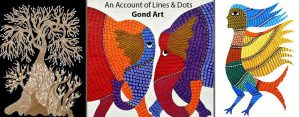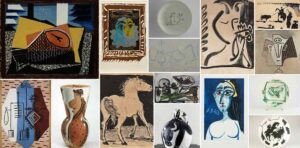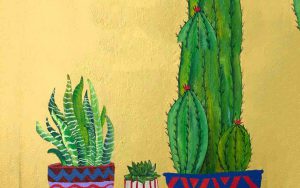Symmetry is employed in many types of art, but the Indian folk art movement has championed bilateral symmetry in particular. Jamini Roy, an Indian folk artist, was a big proponent of employing this type of visual symmetry to make beautiful and fascinating art in a way that was both accessible and affordable for the Indian people, who couldn’t afford to spend a lot of money on painting at the time. Many artists today follow Roy’s lead in bringing beauty into everyday life through the use of bilateral symmetry in Indian traditional art.
What is Kalighat Painting?
Kalighat paintings are a subgenre of Indian folk art, thus it’s vital to grasp what folk art is. There is no hard and fast rule, but folk art can be broadly characterised as works created by rural artists that draw on cultural traditions and use materials found locally. Pieces are typically classified as either useful or ornamental. Cooking utensils, furniture, musical instruments, and tools are examples of functional art; ornamental pieces include wall hangings, apparel, masks, and toys. Aside from their cultural distinctiveness (they come from a single group), all folk art has some visual feature that separates it from mainstream styles—usually an attention to detail or craftsmanship that most commercial products lack.
So, what has kalighat painting to do with any of this? Other than being painted at kalighat, India’s most well-known folk art location, not much. Though widely regarded throughout India for its artistic excellence, kalighat painting cannot be classified as folk because it is so culturally and technically rooted to its location. That isn’t always a bad thing; it allows us to focus on symmetrical abstraction without being distracted by historical context…which means we can simply admire its artistic beauty.
Bilateral Symmetry in Indian Folk Art
Most people associate Indian folk art with vibrant temples and gods with exaggerated characteristics. It’s a lovely reflection of religion and culture. However, there is one characteristic of Indian traditional art that is generally overlooked: bilateral symmetry. This symmetrical structure is not always as evident as others, yet it has a significant presence nevertheless. Bilateral symmetry is important in Indian traditional art for a variety of reasons, including cultural value and effect on other subjects such as math and science. An even distribution on either side of a central axis is referred to as bilateral symmetry.
This results in two almost similar halves and ensures that each side visually balances out its counterpart, creating perfection inside imperfection. Indeed, it may be claimed that without bilateral symmetry, Indian folk art would not have existed or been as easily recognised around the world for as long. Without any symmetry, it may be difficult to tell whether anything is ornamental or merely decorative and chaotic. Asymmetry can be visually pleasant because humans prefer objects that appear balanced and neat; nevertheless, entirely random asymmetries tend to look unplanned and awkward, whereas bilateral symmetry eliminates any appearance of disorderliness.
How Is Bilateral Symmetry Different from Asymmetric Symmetry?
Many people believe that asymmetric symmetry is simply the difference of two sides, however it is considerably more complicated than that. One approach is to first define bilateral symmetry, which essentially states that two sides of an object are identical. Consider a face or a leaf: Two sides are identical. The goal behind asymmetric design is to create intrigue by breaking up perfect bilateral symmetry with purposely placed defects.
If you’re seeking for artists who employ such tactics, Jamini Roy fits right in, and here’s why… Art has always been very important in India since time immemorial. Indeed, evidence of artistic leanings may be found in cave paintings from Bhimbetka to other temples across India. Today, numerous forms of folk art are practised in India, which have benefited from increased tourism in many parts of the country. With UNESCO proclaiming almost three years ago that intangible cultural heritage should be maintained globally, we have slowly begun to see a shift in which folk artists are not only receiving attention from collectors but are also being compensated generously for their work.
How Does Bilateral Symmetry Occur in Nature?
A species with bilateral symmetry, or two identical halves, is known as bilateral or isometry. Humans, cats, horses, and starfish are examples of bilateral organisms. When an organism is symmetrical about an axis running down its centre, this is a type of bilateralism. This axis is known as a sagittal plane, and organisms with dorsoventral symmetry have bilateral symmetry along these planes.


